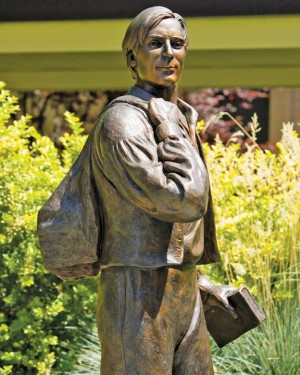 Joseph Smith Jr. was born in South Royalton Vermont just two days before Christmas in 1805. He became the first prophet and president of The Church of Jesus Christ of Latter-day Saints, whose members are often called Mormons. Today a memorial allows visitors, both Mormon and non-Mormon, to learn more about the leader from authentic sources.
Joseph Smith Jr. was born in South Royalton Vermont just two days before Christmas in 1805. He became the first prophet and president of The Church of Jesus Christ of Latter-day Saints, whose members are often called Mormons. Today a memorial allows visitors, both Mormon and non-Mormon, to learn more about the leader from authentic sources.
Although Joseph’s family moved when he was just three years old due to financial hardship, it is the starting place of a story that would change history, not just for Mormons, but for the nation which saw Utah settled in an extraordinary westward migration and for many places in the world that have been helped by the Church’s humanitarian efforts.
The original farm was 100 acres and belonged to his grandfather, Solomon Mack. (Joseph’s mother was Lucy Mack Smith.) Soon after Lucy and her husband, also named Joseph, were married, they moved to that farm to assist with the work. However, crop failures caused the family to have to move.
In 1905, Junius F. Wells, a young Mormon, had a longing to create an official memorial to the first Mormon president. He asked church leaders for permission to buy the land and create the memorial. Permission was given. This led to the realization that the Church needed to purchase and protect other properties that had significance to church history. Eventually, an additional 200 acres next to this property would also be purchased.
Although the original home was gone, Junius began building a new cottage where the original had been built. A granite quarry 35 miles from the property was hired to create an obelisk that was 38 and a half feet tall. Joseph Smith was murdered at age 38 and a half. Due to muddy roads, it took seven weeks to transport the obelisk to the new site. Then they found the final yards were completely impassible. Junius told the workers to go home after an unsuccessful day of effort and promised them they would be able to move it the next morning. He then went home and began to pray for divine intervention. A wind and rain storm raced through the area that night and then, in the course of three and a half hours, the temperature plummeted 35 degrees. The puddles of water froze and in the morning, the workers slid the obelisk across the ice.
 Despite the many challenges, the monument was finished four days before it was dedicated. The dedication was carried out by Joseph Smith’s nephew, Joseph F. Smith, who was then the president of the Church. (Mormons do not pass leadership from father to son, but it does sometimes happen that relatives become church leaders.) The dedication promised it was to be a peaceful place and this is something visitors often comment on.
Despite the many challenges, the monument was finished four days before it was dedicated. The dedication was carried out by Joseph Smith’s nephew, Joseph F. Smith, who was then the president of the Church. (Mormons do not pass leadership from father to son, but it does sometimes happen that relatives become church leaders.) The dedication promised it was to be a peaceful place and this is something visitors often comment on.
A few portions of the original property—the hearthstone and the original doorstep–still exist and can be seen on the property. In addition, visitors can watch a one-hour documentary on Joseph Smith’s life and mission, pictures of the family, and copies of the books Joseph Smith translated through the power of God (the Book of Mormon) or that are the result of revelations received (the Doctrine and Covenants) are on display as well. These are used as scripture along with the King James translation of the Bible by Mormons.
At Christmas time, the property is filled with lights and music, making it a popular destination by those who enjoy a quiet place to celebrate Christmas.
Learn more about the Joseph Smith Birthplace Memorial.
Learn more about Joseph Smith.
About Terrie Lynn Bittner
The late Terrie Lynn Bittner—beloved wife, mother, grandmother, and friend—was the author of two homeschooling books and numerous articles, including several that appeared in Latter-day Saint magazines. She became a member of the Church at the age of 17 and began sharing her faith online in 1992.

 Watch a video about the restoration of the gospel on lds.org
Watch a video about the restoration of the gospel on lds.org
I surely enjoy reading these short historical articles.